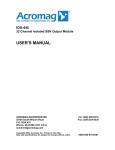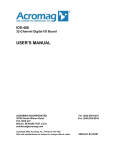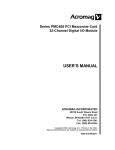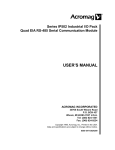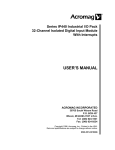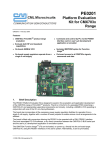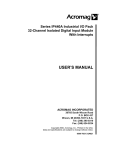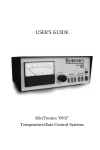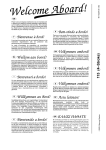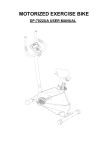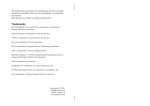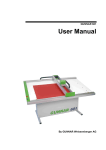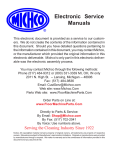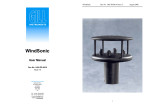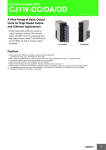Download USER`S MANUAL
Transcript
Series IP445 Industrial I/O Pack 32 Channel Isolated SSR Output Module USER’S MANUAL ACROMAG INCORPORATED 30765 South Wixom Road P.O. BOX 437 Wixom, MI 48393-7037 U.S.A. Tel: (248) 624-1541 Fax: (248) 624-9234 Copyright 1996, Acromag, Inc., Printed in the USA. Data and specifications are subject to change without notice. 8500-552-C98M015 SERIES IP445 INDUSTRIAL I/O PACK 32 CHANNEL ISOLATED SSR OUTPUT MODULE ___________________________________________________________________________________________ The information contained in this manual is subject to change without notice. Acromag, Inc. makes no warranty of any kind with regard to this material, including, but not limited to, the implied warranties of merchantability and fitness for a particular purpose. Further, Acromag, Inc. assumes no responsibility for any errors that may appear in this manual and makes no commitment to update, or keep current, the information contained in this manual. No part of this manual may be copied or reproduced in any form, without the prior written consent of Acromag, Inc. Table of Contents 1.0 GENERAL INFORMATION............................................... KEY IP445 FEATURES..................................................... INDUSTRIAL I/O PACK INTERFACE FEATURES.......... SIGNAL INTERFACE PRODUCTS.................................. INDUSTRIAL I/O PACK SOFTWARE LIBRARY.............. 2.0 PREPARATION FOR USE................................................ UNPACKING AND INSPECTION..................................... CARD CAGE CONSIDERATIONS................................... BOARD CONFIGURATION.............................................. CONNECTORS................................................................. IP Field I/O Connector (P2)............................................ Grounding and Noise Considerations............................. IP Logic Interface Connector (P1).................................. 3.0 PROGRAMMING INFORMATION.................................... IP IDENTIFICATION ROM................................................ I/O SPACE ADDRESS MAP............................................. REGISTER DEFINITIONS................................................ Control Register............................................................. Port Output Registers.................................................... IP445 PROGRAMMING.................................................... 4.0 THEORY OF OPERATION............................................... LOGIC/POWER INTERFACE........................................... OUTPUT PORTS.............................................................. 5.0 SERVICE AND REPAIR.................................................... SERVICE AND REPAIR ASSISTANCE........................... PRELIMINARY SERVICE PROCEDURE......................... 6.0 SPECIFICATIONS............................................................. GENERAL SPECIFICATIONS.......................................... DIGITAL SSR OUTPUTS................................................. INDUSTRIAL I/O PACK COMPLIANCE........................... IMPORTANT SAFETY CONSIDERATIONS It is very important for the user to consider the possible adverse effects of power, wiring, component, sensor, or software failures in designing any type of control or monitoring system. This is especially important where economic property loss or human life is involved. It is important that the user employ satisfactory overall system design. It is agreed between the Buyer and Acromag, that this is the Buyer's responsibility. Page 2 2 3 3 3 3 3 4 4 4 4 5 5 5 5 6 6 6 6 6 7 7 7 7 7 7 8 8 8 8 APPENDIX......................................................................... CABLE: MODEL 5025-550 & 5025-551............................ CABLE: MODEL 5029-900................................................ TERMINATION PANEL: MODEL 5025-552..................... TERMINATION PANEL: MODEL 5029-910..................... TRANSITION MODULE: MODEL TRANS-GP................. 9 9 9 9 9 10 DRAWINGS 4501-434 IP MECHANICAL ASSEMBLY......................... 4501-606 IP445 RESISTOR LOCATION DRAWING...... 4501-604 IP445 FIELD CONNECTIONS......................... 4501-603 IP440/445 LOOPBACK CONNECTIONS........ 4501-605 IP445 BLOCK DIAGRAM................................. 4501-462 CABLE 5025-550 (NON-SHIELDED).............. 4501-463 CABLE 5025-551 (SHIELDED)........................ 4501-464 TERMINATION PANEL 5025-552................... 4501-465 TRANSITION MODULE TRANS-GP............... Page 11 11 12 13 14 15 15 16 16 -2- 1.0 GENERAL INFORMATION The Industrial I/O Pack (IP) Series IP445 module is a bus isolated 32-channel output module. The IP445 provides control for 32 solid state relays which are bipolar and may be used to switch positive or negative voltages. Four units may be mounted on a carrier board to provide up to 128 channels of output control in a single system slot. The IP445 offers a variety of features which make it an ideal choice for many industrial and scientific applications as described below. MODEL IP445 IP445E OPERATING TEMPERATURE RANGE 0 to +70°C -40 to +85°C KEY IP445 FEATURES • High Channel Count - Individual control of up to 32 (SPSTNO) bipolar Solid State Relays (SSR’s) is provided. Four units mounted on a carrier board provide 128 channels in a single system slot. • High-Speed/0 Wait States - No wait states are required for all read/write cycles (all cycles complete in 250nS.) and hold states are supported. • Optically Isolated - Individual bipolar SSR’s provide isolation. The IP445 contains four groups (ports) of eight channels which include separate port commons to ensure port to port isolation. Individual ports are isolated from each other and from the IP logic. • Low-Side or High-Side Switch Configuration - Each group of eight channels can be connected directly to positive or negative supplies for high (hot) side switching. Alternatively, each group of eight channels can be connected to common for low side switching. Socketed pull-up resistors are provided for low side switching applications. • TTL Compatible - When configured as a low side switch will sink 27mA at 0.4 volts. Sourcing is controlled by the installed pull-up resistor. • Power Up & System Reset is Fail-safe - For safety, the outputs are turned OFF upon power-up and a system reset. Thus, the SSR’s will be disabled after a power-up or system reset. • Wide Range Bipolar Voltage Outputs - Outputs are rated from 0 to ±60 volts. The bipolar solid state relays allow both AC and DC switching. • Output Readback Function - Readback buffers are provided that allow the output channel registers to be read back. • Loopback Compatible with IP440 Digital Input Module The P2 field I/O pin assignments of the IP445 output module correspond with those of the Acromag IP440 Bus Isolated Input module. This provides direct closed-loop monitoring of the output states. SERIES IP445 INDUSTRIAL I/O PACK 32 CHANNEL ISOLATED SSR OUTPUT MODULE ___________________________________________________________________________________________ • Model TRANS-GP: This module repeats field I/O connections of IP modules A through D for rear exit from a VMEbus card cage. It is available for use in card cages which provide rear exit for I/O connections via transition modules (transition modules can only be used in card cages specifically designed for them). It is a double-height (6U), single-slot module with front panel hardware adhering to the VMEbus mechanical dimensions, except for shorter printed circuit board depth. It connects to Acromag Termination Panel 5025-552 from the rear of the card cage, and to AVME9630/9660 boards within the card cage, via flat 50-pin ribbon cable (cable Model 5025-550 or 5025-551). No Configuration Jumpers or Switches - All configuration is performed through software commands with no internal jumpers to configure or switches to set. INDUSTRIAL I/O PACK INTERFACE FEATURES High density - Single-size, industry standard, IP module footprint. Four units mounted on a carrier board provide up to 128 isolated output points in a single system slot. Both VMEbus and ISA bus (PC/AT) carriers are supported. • Local ID - Each IP module has its own 8-bit ID signature which can be read via access to the ID space. • 8-bit I/O - Port register Read/Write is performed through 8 or 16-bit data transfer cycles in the IP module I/O space. • High Speed with No Wait States - Access times for all data transfer cycles are described in terms of "wait" states - 0 wait states are required for all read and write operations of this model. See Specification section for detailed information. • INDUSTRIAL I/O PACK SOFTWARE LIBRARY Acromag provides an Industrial I/O Pack Software Library diskette (Model IPSW-LIB-M03, MSDOS format) to simplify communication with the board. Example software functions are provided for both VMEbus and ISA bus (PC/AT) applications. All functions are written in the “C” programming language and can be linked to your application. For more details, refer to the “README.TXT” file in the root directory on the diskette and the “INFO445.TXT” file in the appropriate “IP445” subdirectory off of “\VMEIP” or “\PCIP”, according to your carrier. SIGNAL INTERFACE PRODUCTS (See Appendix for more information on compatible products) This IP module will mate directly to any industry standard IP carrier board (including Acromag AVME9630/9660 3U/6U nonintelligent VMEbus carrier boards). Additionally, Acromag’s APC8600 ISA bus (PC/AT) carrier board is also supported. A wide range of other Acromag IP modules are also available to serve your signal conditioning and interface needs. 2.0 PREPARATION FOR USE UNPACKING AND INSPECTION The following cables and termination panels are also available. Consult your carrier board documentation for the correct interface product part numbers to ensure compatibility with your carrier board. Upon receipt of this product, Inspect the shipping carton for evidence of mishandling during transit. If the shipping carton is badly damaged or water stained, request that the carrier's agent be present when the carton is opened. If the carrier's agent is absent when the carton is opened and the contents of the carton are damaged, keep the carton and packing material for the agent's inspection. Cables Model 5025-551-X (Shielded Cable), or Model 5025-550-X (Non-Shielded Cable): A Flat 50-pin cable with female connectors at both ends for connecting AVME9630/9660, or other compatible carrier boards, to Model 5025-552 termination panels. The “-X” suffix of the model number is used to indicate the length in feet. For repairs to a product damaged in shipment, refer to the Acromag Service Policy to obtain return instructions. It is suggested that salvageable shipping cartons and packing material be saved for future use in the event the product must be shipped. The unshielded cable is recommended for digital I/O, while the shielded cable is recommended for optimum performance with precision analog I/O applications. This board is physically protected with packing material and electrically protected with an anti-static bag during shipment. However, it is recommended that the board be visually inspected for evidence of mishandling prior to applying power. Model 5029-900 APC8600 High-Density Cable: A 36-inch long interface cable that mates the high-density (25mil pitch) 50-pin I/O connectors of the APC8600 ISA bus carrier board, to the high-density connectors on the APC8600 Termination Panel (described below). The board utilizes static sensitive components and should only be handled at a static-safe workstation. Termination Panels: Model 5025-552: A DIN-rail mountable panel that provides 50 screw terminals for universal field I/O termination. Connects to Acromag AVME9630/9660, or other compatible carrier boards, via flat 50-pin ribbon cable (Model 5025-550-X or 5025-551-X). Model 5029-910 APC8600 High-Density-to-Screw-Terminal Termination Panel: This panel converts the high-density ribboncable connectors coming from the APC8600 carrier board (Acromag cable Model 5029-900) to screw terminals, for directwired interfaces. Transition Module: -3- SERIES IP445 INDUSTRIAL I/O PACK 32 CHANNEL ISOLATED SSR OUTPUT MODULE ___________________________________________________________________________________________ Table 2.1: IP445 Field I/O Pin Connections (P2) Pin Description Number Pin Description OD00 1 OD20 OD01 2 OD21 OD02 3 OD22 P OD03 4 OD23 O User Supply 0 5 User Com Out 2 R OD04 6 OD24 T OD05 7 OD25 OD06 8 OD26 0 OD07 9 OD27 User Com Out 0 10 User Supply 3 OD08 11 OD28 OD09 12 OD29 OD10 13 OD30 P OD11 14 OD31 O User Supply 1 15 User Com Out 3 R OD12 16 Not Used T OD13 17 Not Used OD14 18 Not Used 1 OD15 19 Not Used User Com Out 1 20 Not Used OD16 21 Not Used P OD17 22 Not Used O OD18 23 Not Used R OD19 24 Not Used T User Supply 2 25 Not Used 2 CARD CAGE CONSIDERATIONS Refer to the specifications for loading and power requirements. Be sure that the system power supplies are able to accommodate the power requirements of the carrier board, plus the installed IP modules, within the voltage tolerances specified. IMPORTANT: Adequate air circulation must be provided to prevent a temperature rise above the maximum operating temperature. The dense packing of the IP modules to the carrier board restricts air flow within the card cage and is cause for concern. Adequate air circulation must be provided to prevent a temperature rise above the maximum operating temperature and to prolong the life of the electronics. If the installation is in an industrial environment and the board is exposed to environmental air, careful consideration should be given to air-filtering. BOARD CONFIGURATION Power should be removed from the board when installing IP modules, cables, termination panels, and field wiring. Refer to Mechanical Assembly Drawing 4501-434 and your IP module documentation for configuration and assembly instructions. Module IP445 digital output boards have no hardware jumpers or switches to configure. Software configurable control registers are provided for control of all modes of operation. Refer to section 3 for programming details. Number 26 P 27 O 28 R 29 T 30 2 31 32 33 P 34 O 35 R 36 T 37 38 3 39 40 41 42 43 44 45 46 47 48 49 50 The output channels of this module are divided into four ports of eight channels each. All channels within a port share a common signal connection with each other. Isolation is provided between the ports and the IP logic. In addition, bus isolation is provided between ports. This module is built with socketed output pull-up resistors installed. These may be used when the SSR’s are applied as low side switches. Resistor values may be changed if needed, and the resistors may be removed for high side switching (see IP445 Resistor Location Drawing 4501-606). P2 pin assignments are arranged to be compatible with similar Acromag models. This model is directly loopback compatible with the Acromag Model IP440 32-Channel Digital Input Board. Likewise, pin assignments are identical to those of Acromag Model IP405 40-Channel Digital Output Boards for channels 0-31, except for the user supply connections. This model (remove socketed pullup resistors) may also interface with industry accepted I/O panels, termination panels, and relay racks when used with the Acromag Model 5025-655 I/O Adapter Card. However, relay racks are usually isolated in which case it would probably be more efficient to use the non-isolated IP405 module. Consult the factory for information on these and other compatible products. CONNECTORS IP Field I/O Connector (P2) P2 provides the field I/O interface connections for mating IP modules to the carrier board. P2 is a 50-pin female receptacle header (AMP 173279-3 or equivalent) which mates to the male connector of the carrier board (AMP 173280-3 or equivalent). This provides excellent connection integrity and utilizes gold-plating in the mating area. Threaded metric M2 screws and spacers are supplied with the module to provide additional stability for harsh environments (see Mechanical Assembly Drawing 4501-434). The field and logic side connectors are keyed to avoid incorrect assembly. Refer to Drawing 4051-604 for example field output connections. See Drawing 4501-603 for loopback connections to Acromag Model IP440 Input Modules. P2 pin assignments are unique to each IP model (see Table 2.1) and normally correspond to the pin numbers of the field I/O interface connector on the carrier board (you should verify this for your carrier board). Note that the outputs of this module are bipolar, and may be connected in any direction with respect to the port common. Further, do not confuse port commons with signal ground. For the IP445, port common only infers that this lead is connected common to the 8 outputs of the port (a separate common for each port). The port commons of the IP445 output module and IP440 input module are normally not connected together for loopback interconnection (see Drawing 4501-603). -4- SERIES IP445 INDUSTRIAL I/O PACK 32 CHANNEL ISOLATED SSR OUTPUT MODULE ___________________________________________________________________________________________ Grounding and Noise Considerations 3.0 PROGRAMMING INFORMATION Output lines of the IP445 are optically isolated between the logic and field output connections. Likewise, separate port commons ensure port-to-port isolation. Consequently, the field I/O connections are isolated from the carrier board and backplane, thus minimizing the negative effects of ground bounce, impedance drops, and switching transients. However, care should be taken in designing installations to avoid inadvertently compromising isolation, or creating ground loops which can cause noise pickup and reduce overall system reliability. IP IDENTIFICATION SPACE - (Read Only, 32 Odd-Byte Addresses) Each IP module contains identification (ID) information that resides in the ID space per the IP module specification. This area of memory contains 32 bytes of information at most. Both fixed and variable information may be present within the ID space. Fixed information includes the "IPAC" identifier, model number, and manufacturer's identification codes. Variable information includes unique information required for the module. The IP445 ID information does not contain any variable (e.g. unique calibration) information. ID space bytes are addressed using only the odd addresses in a 64 byte block (on the “Big Endian” VMEbus). Even addresses are used on the “Little Endian” PC ISA bus. The IP445 ID space contents are shown in Table 3.1. Note that the baseaddress for the IP module ID space (see your carrier board instructions) must be added to the addresses shown to properly access the ID space. Execution of an ID space read requires 0 wait states. IP Logic Interface Connector (P1) P1 of the IP module provides the logic interface to the mating connector on the carrier board. The pin assignments of P1 are standard for all IP modules according to the Industrial I/O Pack Specification (see Table 2.2). The IP Logic Interface connector is a 50-pin female receptacle header (AMP 173279-3 or equivalent) which mates to the male connector of the carrier board (AMP 173280-3 or equivalent). This provides excellent connection integrity and utilizes gold-plating in the mating area. Threaded metric M2 screws and spacers are supplied with the IP module to provide additional stability for harsh environments (see Drawing 4501-434 for assembly details). Field and logic side connectors are keyed to avoid incorrect assembly. Table 3.1: IP445 ID Space Identification (ID) ROM Hex Offset Numeric ASCII From ID Value Character ROM Base (Hex) Field Description Equivalent Address 01 I 49 All IP's have 'IPAC' 03 P 50 05 A 41 07 C 43 09 A3 Acromag ID Code 0B 09 IP Model Code1 0D 00 Not Used (Revision) 0F 00 Reserved 11 00 Not Used (Driver ID Low Byte) 13 00 Not Used (Driver ID High Byte) 15 0C Total Number of ID ROM Bytes 17 8C CRC 19 to 3F yy Not Used Table 2.2: Standard Logic Interface Connections (P1) Pin Description Number Pin Description Number GND 1 GND 26 CLK 2 +5V 27 Reset* 3 R/W* 28 D00 4 IDSEL* 29 D01 5 30 DMAReq0* D02 6 MEMSEL* 31 D03 7 32 DMAReq1* D04 8 IntSel* 33 D05 9 34 DMAck0* D06 10 IOSEL* 35 D07 11 36 RESERVED 12 A1 37 D08 13 38 D09 DMAEnd* 14 A2 39 D10 15 40 D11 ERROR* 16 A3 41 D12 17 42 D13 INTReq0* 18 A4 43 D14 19 44 D15 INTReq1* BS0* 20 A5 45 21 46 BS1* STROBE* 22 A6 47 -12V 23 ACK* 48 +12V +5V 24 49 RESERVED GND 25 GND 50 An Asterisk (*) is used to indicate an active-low signal. BOLD ITALIC Logic Lines are NOT USED by this IP Model. Notes (Table 3.1): 1. The IP model number is represented by a two-digit code within the ID space (the IP445 model is represented by 09 Hex). 2. Execution of an ID space read requires 0 wait states. -5- SERIES IP445 INDUSTRIAL I/O PACK 32 CHANNEL ISOLATED SSR OUTPUT MODULE ___________________________________________________________________________________________ I/O SPACE ADDRESS MAP Port Output Registers (Read/Write, 03H, 05H, 07H, and 09H) This board is addressable in the Industrial Pack I/O space to control the 32 channels of digital output to the field. Four registers are provided to control 32 possible output points. Data can be read from or written to one of four groups of eight output lines (Ports 0-3), as designated by the address and read/write signals. Each port assigns the least significant data line (D0) to the least significant output line of the port grouping (e.g. OD00 for port 0 to D0). The I/O space may be as large as 64, 16-bit words (128 bytes) using address lines A1 to A6, but the IP445 uses only a portion of this space. The I/O space address map for the IP445 is shown in Table 3.2. Note that the base address for the IP module I/O space (see your carrier board instructions) must be added to the addresses shown to properly access the I/O space. Accesses may be performed on an 8 or 16-bit basis but only D0-D7 are driven. D08D15 are not used but will normally read high due to pull-up resistors on the carrier board. REGISTER 0 (OUTPUT SWITCHES 00 THROUGH 07): MSB __ __ __ __ __ __ LSB 07 06 05 04 03 02 01 00 CH07.........................................................................................CH00 REGISTER 1 (OUTPUT SWITCHES 08 THROUGH 15): MSB __ __ __ __ __ __ LSB 07 06 05 04 03 02 01 00 CH15.........................................................................................CH08 The following table shows the memory map for the IP445. Data is read and written to one of four groups (ports) as designated by the address. REGISTER 2 (OUTPUT SWITCHES 16 THROUGH 23): MSB __ __ __ __ __ __ LSB 07 06 05 04 03 02 01 00 CH23.........................................................................................CH16 Table 3.2: IP445 I/O Space Address (Hex) Memory Map2 Base MSB LSB Base Addr+ D15 D08 D07 D00 Addr+ Not Used Control Register 00 01 Not Used Output Port 0 02 CH07 03 ↔ CH00 Not Used Output Port 1 04 CH15 05 ↔ CH08 Not Used Output Port 2 06 CH23 07 ↔ CH16 Not Used Output Port 3 08 CH31 09 ↔ CH24 Not Used 0A ⇓ 0B Not Used 7E 7F REGISTER 3 (OUTPUT SWITCHES 24 THROUGH 31): MSB __ __ __ __ __ __ LSB 07 06 05 04 03 02 01 00 CH31.........................................................................................CH24 Write a zero to each channel’s position to turn the corresponding SSR OFF. Write a one to each channel’s position to turn the corresponding SSR ON. Each output channel register can be conveniently read back for verification purposes. For critical control applications, it is recommended that outputs be directly fed back to an input point and the input point monitored (loopback I/O). Acromag Model IP440 32channel isolated input modules can be used to implement loopback output monitoring with this model (see Drawing 4501-603). Notes (Table 3.2): 1. The IP will not respond to addresses that are "Not Used". 2. All Register accesses implement 0 wait state data transfers. On power-up, hardware reset, or software reset, the ports are reset to 0 forcing the outputs (SSR’s) to be OFF. This memory map reflects byte accesses using the “Big Endian” byte ordering format. Big Endian is the convention used in the Motorola 68000 microprocessor family and is the VMEbus convention. In Big Endian, the lower-order byte is stored at odd-byte addresses. The Intel x86 family of microprocessors uses the opposite convention, or “Little Endian” byte ordering. Little Endian uses even-byte addresses to store the low-order byte. As such, installation of this module on a PC carrier board will require the use of the even address locations to access the lower 8 data bits while on a VMEbus carrier use of odd address locations are required. IP445 PROGRAMMING Acromag provides you with the Industrial I/O Pack Software Library diskette (Model IPSW-LIB-M03, MSDOS format) to make communication with the board easy. Example software functions are provided for both ISAbus (PC/AT) and VMEbus applications. All functions are written in the “C” programming language and can be linked to your application. For more details, refer to the “README.TXT” file in the root directory on the diskette and the “INFO445.TXT” file in the appropriate “IP445” subdirectory off of “\VMEIP” or “\PCIP”, according to your carrier. REGISTER DEFINITIONS Control Register, (Write) - (Base + 00H) This write only register is used to reset all output ports to 0 (SSR switches OFF). Table 3.3: Control Register BIT FUNCTION 0 1 = Software Reset 1 to 7 Not Used -6- SERIES IP445 INDUSTRIAL I/O PACK 32 CHANNEL ISOLATED SSR OUTPUT MODULE ___________________________________________________________________________________________ 4.0 THEORY OF OPERATION The SSR’s employed are rated for a much higher voltage than specified. However, the field connector and printed circuit board foil spacings limit applied voltages to +/-60VDC or AC peak. Each port (group of eight channels) has a single common. Since the connectors and cables are rated to 1A maximum per pin, then each port is limited to that total current. Thus, the sum of currents conducted by the 8 channels must stay below that total (see specifications in Chapter 6 for details). The low on resistance of the SSR’s helps reduce their power dissipation when they conduct high currents; however, given the large number of channels on the board adequate air circulation must be maintained. The SSR’s used in the IP445 are very rugged and contain built-in current limiting for their protection. They provide clean, bounce free switching and can replace electromechanical relays in many applications. SSR switching speeds are comparable to electromechanical relays (1mS. typical) but are slow compared to high speed optocouplers. This section contains information regarding the basic functionality of the circuitry used on the IP445. Refer to the Block Diagram shown in Drawing 4501-605 as you review this material. LOGIC/POWER INTERFACE The logic interface to the carrier board is made through connector P1 (refer to Table 2.2). The P1 interface also provides +5V power to the module. Note that data lines D08..D15, BS1*, the DMA control, interrupt requests (INTREQ0∗ and INTREQ1∗), ERROR∗, STROBE∗ and +/-12V power signals are not used. A Field Programmable Gate-Array (FPGA) installed on the IP Module provides an interface to the carrier board per IP Module specification revision 0.7.1. The interface to the carrier board allows complete control of all IP445 functions. This logic includes: address decoding, I/O and ID read/write control circuitry, and ID space implementation. With regard to throughput, 0 wait states are required for read and write operations. Output operation is “Fail-safe”. That is, the outputs are always OFF upon power-up reset, and are automatically cleared following a software (control register) or system software reset. This is done for safety reasons to ensure reliable control of the output state under all conditions. Address decoding of the six IP address signals A(1:6) is implemented in the FPGA, in conjunction with the IP select signals, to identify access to the IP module’s ID or I/O space. In addition, the byte strobe BS0∗ is decoded to identify a low byte data transfer. 5.0 SERVICE AND REPAIR SERVICE AND REPAIR ASSISTANCE OUTPUT PORTS Surface-Mounted Technology (SMT) boards are generally difficult to repair. It is highly recommended that a non-functioning board be returned to Acromag for repair. The board can be easily damaged unless special SMT repair and service tools are used. Further, Acromag has automated test equipment that thoroughly checks the performance of each board. When a board is first produced and when any repair is made, it is tested, placed in a burnin room at elevated temperature, and retested before shipment. The field I/O interface to the carrier board is provided through connector P2 (refer to Table 2.1). Individual Solid State Relays (SSR’s) for each channel isolate the field from the control logic for the IP445. Channels are isolated from each other in groups of eight. There are eight channels to a group or port. Because the output lines of a single port share a common connection, individual outputs are not isolated from each other within the same port. However, separate port commons are provided to facilitate port-to-port isolation. Please refer to Acromag's Service Policy Bulletin or contact Acromag for complete details on how to obtain parts and repair. 32 Single Pole Single Throw - Normally Open (SPST-NO, “1 Form A”) SSR outputs are controlled by this module. Each group of eight channels can be connected directly to positive or negative supplies for high (hot) side switching. Alternatively, each group of eight channels can be connected to common for low side switching. Socketed pull-up resistors are provided for low side switching applications. These resistors should be removed if high side switching is needed. In low side switching applications the resistor values can be changed (e.g. lower values will provide a faster pull-up while a higher values will keep power dissipation from becoming a problem at higher voltages) - see Specifications in Chapter 6 for details. PRELIMINARY SERVICE PROCEDURE Before beginning repair, be sure that all of the procedures in Section 2, Preparation For Use, have been followed. Also, refer to the documentation of your carrier board to verify that it is correctly configured. Replacement of the module with one that is known to work correctly is a good technique to isolate a faulty module. CAUTION: POWER MUST BE TURNED OFF BEFORE REMOVING OR INSERTING BOARDS Acromag’s Applications Engineers can provide further technical assistance if required. When needed, complete repair services are also available from Acromag. The SSR’s are controlled by output registers within the FPGA. Writing a ‘1’ to the output register will turn the switch ON (closedcircuit) while writing a ‘0’ will turn it OFF (open-circuit). Readback of the output state is accomplished by reading the output registers. However, for complete confidence in output control, loopback should be performed. This may be accomplished using the IP440 isolated digital input module (refer to drawing 4501-603). -7- SERIES IP445 INDUSTRIAL I/O PACK 32 CHANNEL ISOLATED SSR OUTPUT MODULE ___________________________________________________________________________________________ 6.0 SPECIFICATIONS switching) operation. SPST-NO, “1 Form A” contacts. “OFF” Voltage Range.....................0 to +/-60V DC or peak AC. Output “OFF” Leakage Current......1uA Maximum (over temp.). Output “ON” Current Range...........140mA Maximum continuous (up to 1A total per port) No deration required at elevated ambients. Output ON Resistance..................15Ω, Maximum (25°C). Output Current Limiting..................480mA Maximum. Turn-ON Time................................1mS. Typical, 2mS. Maximum. Turn-OFF Time..............................1mS. Typical, 2mS. Maximum. Reset Condition..............................All output SSR’s OFF. Output Pull-up Resistors................Socketed 4.7KΩ (used in low side switching applications). See 4501-606: Res. Loc. Dwg. Calculate resistor power for user supplied voltage (Power = V2/R). Limit power to 0.1 Watt per resistor (21.7V max. @ 4.7KΩ). Remove or insert higher value (consult factory) for higher voltages. Install lower value (check power) to obtain faster, stronger pull-up. Remove for high side switching applications. TTL Compatibility...........................Yes, used as low side switch can sink 27mA. @ 0.4V Maximum; source 500uA @ 2.4V Min. with 4.7KΩ pull-up to 5V supply. Resistance to RFI...........................No digital upsets occur for field strengths up to 10V per meter at 27MHz, 151MHz, & 460MHz per SAMA PMC 33.1 test procedures. Resistance to EMI..........................Unit has been tested with no digital upsets under the influence of EMI from switching solenoids, commutator motors, and drill motors. ESD Protection..............................Output lines are protected from ESD voltages to ± 4KV, typical. May degrade 4.7K pullups by approximately 5%. GENERAL SPECIFICATIONS Operating Temperature.................0 to +70°C. -40 to +85°C (E Version) Relative Humidity..........................5-95% non-condensing. Storage Temperature....................-40 to +125°C. Physical Configuration..................Single Industrial I/O Pack Module. Length....................................3.880 inches (98.5 mm). Width.....................................1.780 inches (45.2 mm). Board Thickness....................0.062 inches (1.59 mm). Max Component Height..........0.314 inches (7.97 mm). Connectors: P1 (IP Logic Interface)............50-pin female receptacle header (AMP 173279-3 or equivalent). P2 (Field I/O)..........................50-pin female receptacle header (AMP 173279-3 or equivalent). Power Requirements: +5 Volts (±5%) All On.............300mA, Typical 400mA, Maximum. +5 Volts (±5%) All Off.............8.5mA, Typical 12mA, Maximum. ±12 Volts (±5%) from P1........0mA (Not Used). Isolation.........................................Logic and field connections are optically isolated by SSR’s. Individual ports are also isolated from each other. However, output lines of individual ports share a common connection and are not isolated from each other. Separate port commons are provided to facilitate port-to-port isolation. IP Logic and field lines are isolated from each other for voltages up to 250VAC, or 354V DC on a continuous basis (unit will withstand a 1250V AC dielectric strength test for one second without breakdown). This complies with test requirements outlined in ANSI/ISA-S82.011988 for the voltage rating specified. Port to port isolation is less critical and is specified as 100V DC. Isolation Spacing...........................Printed circuit board minimum isolation spacings are as follows: Port-to-Logic: 0.024” Minimum (inner layer), 0.071” Minimum (external layer). Port-to-Port: 0.012” Minimum (inner layer), 0.040” Minimum (external layer). INDUSTRIAL I/O PACK COMPLIANCE Specification.................................This module meets or exceeds all written Industrial I/O Pack specifications per revision 0.7.1. Electrical/Mechanical Interface.....Single-Size IP Module. IP Data Transfer Cycle Types Supported: Input/Output (IOSel*).............D16 or D08 least significant read/write of port data. ID Read (IDSel*)....................32 x 8 ID ROM read on D0..D7. Access Times (8MHz Clock): ID ROM Read........................0 wait states (250ns cycle). Port Registers (R/W).............0 wait states (250ns cycle). DIGITAL (SSR) OUTPUTS Output Channel Configuration.......32 isolated Solid State Relay (SSR) outputs supporting AC or DC (high or low side -8- SERIES IP445 INDUSTRIAL I/O PACK 32 CHANNEL ISOLATED SSR OUTPUT MODULE ___________________________________________________________________________________________ APPENDIX of the Industrial I/O Pack modules. Field signals are accessed via screw terminal strips. The terminal strip markings on the termination panel (1-50) correspond to P2 (pins 1-50) on the Industrial I/O Pack (IP). Each Industrial I/O Pack (IP) has its own unique P2 pin assignments. Refer to the IP module manual for correct wiring connections to the termination panel. Schematic and Physical Attributes: See Drawing 4501-464. Field Wiring: 50-position terminal blocks with screw clamps. Wire range 12 to 26 AWG. Connections to AVME9630/9660: P1, 50-pin male header with strain relief ejectors. Use Acromag 5025-550-x or 5025-551-x cable to connect panel to VME board. Keep cable as short as possible to reduce noise and power loss. Mounting: Termination panel is snapped on the DIN mounting rail. Printed Circuit Board: Military grade FR-4 epoxy glass circuit board, 0.063 inches thick. Operating Temperature: -40°C to +100°C. Storage Temperature: -40°C to +100°C. Shipping Weight: 1.25 pounds (0.6kg) packaged. CABLE: MODEL 5025-550-x (Non-Shielded) MODEL 5025-551-x (Shielded) Type: Flat Ribbon Cable, 50-wires (female connectors at both ends). The ‘-x’ suffix designates the length in feet (12 feet maximum). Choose shielded or unshielded cable according to model number. The unshielded cable is recommended for digital I/O, while the shielded cable is recommended for optimum performance with precision analog I/O applications. Application: Used to connect a Model 5025-552 termination panel to the AVME9630/9660 non-intelligent carrier board A-D connectors (both have 50-pin connectors). Length: Last field of part number designates length in feet (userspecified, 12 feet maximum). It is recommended that this length be kept to a minimum to reduce noise and power loss. Cable: 50-wire flat ribbon cable, 28 gage. Non-Shielded cable model uses Acromag Part 2002-211 (3M Type C3365/50 or equivalent). Shielded cable model uses Acromag Part 2002-261 (3M Type 3476/50 or equivalent). Headers (Both Ends): 50-pin female header with strain relief. Header - Acromag Part 1004-512 (3M Type 3425-6600 or equivalent). Strain Relief - Acromag Part 1004-534 (3M Type 3448-3050 or equivalent). Keying: Headers at both ends have polarizing key to prevent improper installation. Schematic and Physical Attributes: For Non-Shielded cable model, see Drawing 4501-462. For Shielded cable model, see Drawing 4501-463. Shipping Weight: 1.0 pound (0.5Kg) packaged. TERMINATION PANEL: MODEL 5029-910 Type: Screw-Terminal Termination Panel For Acromag APC8600 PC/AT ISA bus Carrier Boards. Application: This panel converts the high-density ribbon-cable connectors coming from the APC8600 carrier board (Acromag cable Model 5029-900) to screw terminals, for direct-wired interfaces. This panel facilitates the connection of up to 50 field I/O signals and connects to the APC8600 PC/AT ISA bus carrier board via high-density (25-mil pitch) flat ribbon cable and connectors (see cable Model 5029-900). The A & B connectors on the carrier board connect the field I/O signals to the P2 connector on each of the Industrial I/O Pack modules. Field signals are accessed via screw terminal strips. Each Industrial I/O Pack (IP) has its own unique P2 pin assignments. Refer to the IP module manual for correct wiring connections to the termination panel. Field Wiring: 50-position terminal blocks with screw clamps. Wire range 12 to 26 AWG. Connections to APC8600: P1, 50-pin, high-density male header with strain relief. Mounting: Termination Panel includes mounting holes. Printed Circuit Board: Military grade FR-4 epoxy glass circuit board, 0.063 inches thick. Operating Temperature: -40°C. to +85°C. Storage Temperature: -55°C to +125°C. Shipping Weight: 1.25 pounds (0.6kg) packaged. CABLE: MODEL 5029-900 Type: Model 5029-900 APC8600 High-Density Cable: A 36-inch long interface cable that mates the high-density (25mil pitch) 50pin I/O connectors of the APC8600 PC/AT ISA bus carrier board, to the high density connectors on the APC8600 Termination Panels (described below). Application: Used with the APC8600 PC carrier and termination panel. It mates the high-density (25mil pitch) 50-pin I/O connectors of the APC8600 PC/AT ISA bus carrier board, to the high density connectors on the APC8600 Termination Panel (described below). Length: 36-inches Cable: 50-wire flat ribbon cable, 28 gage, Non-Shielded, T&B/Ansley Part 135-050 or equivalent. Headers: 50-pin, high-density, 25-mil pitch, female header. HeaderT&B Ansley Part 311-050302 or equivalent. Keying: Headers at both ends have polarizing key to prevent improper installation. Shipping Weight: 1.0 pound (0.5Kg) packaged. TRANSITION MODULE: MODEL TRANS-GP Type: Transition module for AVME9630/9660 boards. Application: To repeat field I/O signals of IP modules A through D for rear exit from VME card cages. This module is available for use in card cages which provide rear exit for I/O connections via transition modules (transition modules can only be used in card cages specifically designed for them). It is a double-height (6U), single-slot module with front panel hardware adhering to the VMEbus mechanical dimensions, except for shorter printed circuit board depth. Connects to Acromag termination panel 5025-552 from the rear of the card cage, and to AVME9630/9660 boards within card cage, via flat 50-pin ribbon cable (cable Model 5025-551-X). Schematic and Physical Attributes: See Drawing 4501-465. TERMINATION PANEL: MODEL 5025-552 Type: Termination Panel For AVME9630/9660 Boards Application: To connect field I/O signals to the Industrial I/O Pack (IP). Termination Panel: Acromag Part 4001-040 (Phoenix Contact Type FLKM 50). The 5025-552 termination panel facilitates the connection of up to 50 field I/O signals and connects to the AVME9630/9660 3U/6U non-intelligent carrier boards (A-D connectors only) via a flat ribbon cable (Model 5025-550-x or 5025-551-x). The A-D connectors on the carrier board connect the field I/O signals to the P2 connector on each -9- SERIES IP445 INDUSTRIAL I/O PACK 32 CHANNEL ISOLATED SSR OUTPUT MODULE ___________________________________________________________________________________________ Field Wiring: 100-pin header (male) connectors (3M 3433-D303 or equivalent) employing long ejector latches and 30 micron gold in the mating area (per MIL-G-45204, Type II, Grade C). Connects to Acromag termination panel 5025-552 from the rear of the card cage via flat 50-pin ribbon cable (cable Model 5025-551-X). Connections to AVME9630/9660: 50-pin header (male) connectors (3M 3433-1302 or equivalent) employing long ejector latches and 30 micron gold in the mating area (per MIL-G-45204, Type II, Grade C). Connects to AVME9630/9660 boards within the card cage via flat 50-pin ribbon cable (cable Model 5025-551-X). Mounting: Transition module is inserted into a 6U-size, single-width slot at the rear of the VMEbus card cage. Printed Circuit Board: Six-layer, military-grade FR-4 epoxy glass circuit board, 0.063 inches thick. Operating Temperature: -40°C to +85°C. Storage Temperature: -55°C to +105°C. Shipping Weight: 1.25 pounds (0.6Kg) packaged. - 10 -





















